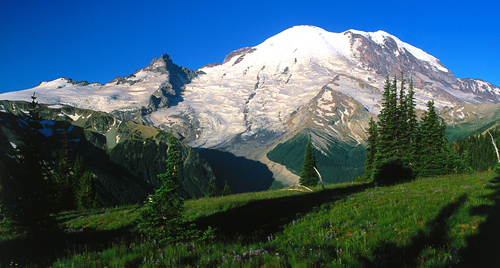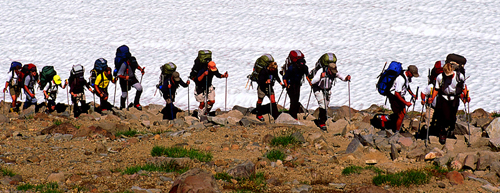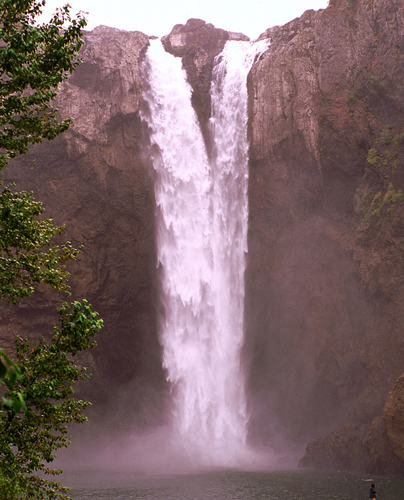Mount Rainier This
silent, snowcapped sentinel, the centerpiece of Mount Rainier National
Park, is an awe-inspiring active volcano rising 14,410-ft (4,392-m)
above sea level. Since the cataclysmic explosion of Mount St. Helens in
1980, the Grand Dame of the Cascades commands new respect for its
potentially devastating force.

View of Mount Rainier

Hikers at Paradise, Mount Rainier
Mount Si Seattle’s
closest Cascade Mountain, the rocky outcropping of Mount Si is just
past Issaquah. The hike is steep but not too difficult, and the views of
the Snoqualmie Valley watershed and I-90 are rewarding. Issaquah Alps This
series of foothills west of the Cascades are remnants of mountains that
predate the higher and more visited peaks to the east. Cougar, Squak,
Tiger, and Rattlesnake Mountains are four main park areas that attract
individuals and families seeking woodland walks without steep drops or
high altitude. Snoqualmie Falls Local
Native American tribes regarded Snoqualmie Falls as a sacred place. The
276-ft (84-m) waterfall, beautifully divided in two sections by a
convenient rock outcropping, marks the end of the Cascade Plateau, where
the Snoqualmie River begins its final descent to the sea. An
observation deck and a steep path to the river allow for close-up
breathtaking views.

Snoqualmie Falls
Twin Falls Hikers
wanting a short spell of deep woods and water head to Olallie State
Park, where a 3-mile (5-km) trail to Twin Falls awaits. The park’s
amazing plant life includes giant ferns and salmonberry, and some of the
Cascades’ few old-growth trees. One Douglas fir has a circumference of
14 ft (4 m). Denny Creek Hiking
near Snoqualmie Pass along I-90 is a mecca for families with kids. The
creek pours over a series of rocks and creates pools for perfect
old-fashioned swimming hole fun. Tonga Ridge The
6.5-mile (10-km) trail in the Alpine Lakes Wilderness offers a pleasant
walk through forests and wild berry picking when the season’s right.
Meadows bloom in a kaleidoscope of colors in late spring, and mountain
scenery abounds. Staircase Rapids The
ferry crossing and subsequent scenic drive along the Hood Canal enhance
the journey to these rapids. The popular route inches near the
fast-flowing Skokomish River as it pours down the eastern slopes of the
Olympic Range on its way to Lake Cushman. Look out for kingfishers,
harlequin ducks, and giant salamanders on the 2-mile (3-km) loop. Hurricane Ridge Drive
to this 5,230-ft (1,594-m) mountain top at one of Olympic National
Park’s most visited sites. The routes are paved, and bring visitors to
one of the best 360-degree alpine overlooks. In winter, when the
snowpack is immensely deep, the roads remain open for skiers and
snowshoers. Big Four Ice Caves Global
warming has taken a toll on ice caves, but the attraction at the base
of 6,153-ft (1,875-m) Big Four Mountain in the North Cascades is still
vital. Hike the 1-mile (1.6-km) trail off the Mountain Loop Highway to
the Ice Caves, the unusual result of alpine avalanches and climate
conditions impacting the ice field at the mountain’s base.
Top 10 Features of Mount Rainier
Paradise Leads
to wildflower-filled meadows, and trails starting at 5,400-ft (1,646-m)
to moraines and majestic views of the Nisqually Glacier. Sunrise Recommended as starting point for solitary hikes. Summit Climb A
round-trip to the crater and back requires training, professional gear,
and a few days. Hire a guide or go with a group if you’re not a
seasoned climber. Family Day Hikes Dozens of trails for family day trips and picnics are available; try one out near the Carbon River entrance. Wonderland Trail This
93-mile (149-km) trail through several mini-ecosystems around the
mountain is ideal for serious backpackers with weeks to spare. Cloud Lid Rainier’s cloud cover often resembles a flying saucer hovering above the peak. Glacial Melting Climate changes have decreased the area of Rainier’s permanent snow cap and facilitated glacial retreats. Jökulhlaups & Lahars Glacial floods and debris flows can move at speeds up to 60 mph (95.5 km/h). Sleeping Giant Experts agree that it’s a question of when, and not if, Mount Rainier’s active volcano will blow again. Pollution’s Effects Smog from automobile traffic now obscures the mountain more and more.
|